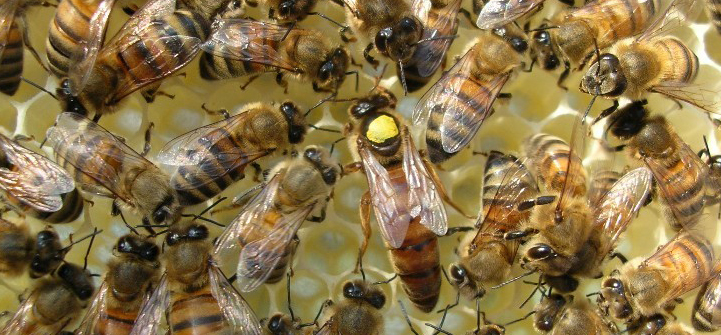Nosema disease in honey bees is caused by two species of pathogens, Nosema apis and Nosema ceranae. Nosema apis was the only known microsporidian honey bee pathogen until 1996, when a second species, Nosema ceranae, was identified from the Asian honey bee. Nosema ceranae appears to be the dominant species in the European honey bee (Apis mellifera) in many parts of the world, including in Europe and the United States. Both of these pathogens cause chronic deleterious effects in the …
How is Nosema disease treated?
Nosema disease can be treated successfully with Fumigillin (trade name Fumidil). Colonies are usually treated in the fall, spring, or both. Follow the directions on the label and feed the correct dosage in 50% sugar syrup (1:1 sugar:water, with antibiotic dissolved in 5-10 ml warm water then mixed into the syrup) in the spring, 66% in the fall. Nosema ceranae also responds to Fumidil treatment, but may require a higher dosage. The antibiotic does not kill the spores, but disrupts …
How do I know whether my bees have Nosema disease?
The only way to be sure is to examine bees by microscope. A sample of bees is macerated in a small amount of water, and then a drop of the liquid is examined on a microscope slide at 400 power. Spores appear as ovals, about 3 by 5 microns. One outward indication of Nosema is brown spots (fecal material) on the outside or inside of a hive. The inner cover or top bars can be soiled with feces in a …
Managed Pollinator CAP Update: Nosema apis and Nosema ceranae: A comparative study in the honey bee host
 Nosema apis and Nosema ceranae: A comparative study
Nosema apis and Nosema ceranae: A comparative study
Nosema apis and Nosema ceranae: A comparative study in the honey bee host
Authors: Wei-Fone Huang and Leellen F. Solter, Illinois Natural History Survey, Prairie Research Institute, University of Illinois
Originally Published in Bee Culture and American Bee Journal, March 2013
Introduction
Nosema apis and Nosema ceranae are genetically related microsporidian pathogens that infect the western honey bee. Both species cause chronic disease that that can shorten the adult lifespan and …
Sunlight, Water and Nosema Spores

A National Research and Extension Initiative to Reverse Pollinator Decline
This is part of an ongoing series of updates from the Managed Pollinator CAP. Additional installments can be found at the:
More information about the CAP can be found at:
by Thomas C. Webster, College of Agriculture, Food Science and Sustainable Systems, Kentucky State University, Frankfort, KY
CAP Updates: 26
- Jointly published in the American Bee Journal
Effects of Nosema on Honey Bee Behavior and Physiology

A National Research and Extension Initiative to Reverse Pollinator Decline
This is part of an ongoing series of updates from the Managed Pollinator CAP. Additional installments can be found at the:
More information about the CAP can be found at:
CAP Updates: 19
by Zachary Huang, Department of Entomology, Michigan State University, E. Lansing, MI 48824
Jointly published in the American Bee Journal and in Bee Culture…
Nosema Microsporidia: Friend Foe and Intriguing Creatures

A National Research and Extension Initiative to Reverse Pollinator Decline
This is part of an ongoing series of updates from the Managed Pollinator CAP. Additional installments can be found at the:
More information about the CAP can be found at:
CAP Updates: 13
Microsporidia: Friend, Foe (and Intriguing Creatures)
Leellen F. Solter, Illinois Natural History Survey, Institute of Natural Resources Sustainability, …
ABRC2010 Disinfection of Nosema ceranae Infected Comb by Irradiation Acetic Acid and Heat
The following was presented at the 2010 American Bee Research Conference in Orlando, FL.
24. Pernal, S.F., A. Ibrahim & A.P. Melathopoulos – DISINFECTION OF NOSEMA CERANAE-CONTAMINATED COMB BY IRRADIATION, ACETIC ACID FUMIGATION AND HEAT – Nosema ceranae is an endoparasite first described from Apis cerana (Fries et al., 2006 Eur. J. Protistol. 32:356-365) that has subsequently spread to populations of Apis mellifera in Europe and throughout the world (Higes et al., 2006 J. Invertebr. Pathol. 92:93-95; Klee et …
Breeding Bees for Resistance to Parasites and Diseases

A National Research and Extension Initiative to Reverse Pollinator Decline
This is part of an ongoing series of updates from the Managed Pollinator CAP. Additional installments can be found at the:
More information about the CAP can be found at:
CAP Updates: 9
Greg Hunt, Purdue University
- Jointly published in the American Bee Journal and in Bee Culture, July 2010.
Those of you who have been …
Nosema ceranae The Inside Story

A National Research and Extension Initiative to Reverse Pollinator Decline
This is part of an ongoing series of updates from the Managed Pollinator CAP. Additional installments can be found at the:
More information about the CAP can be found at:
CAP Updates: 6
Tom Webster, Kentucky State University, Frankfort, KY
- Jointly published in the American Bee Journal and in Bee Culture,


